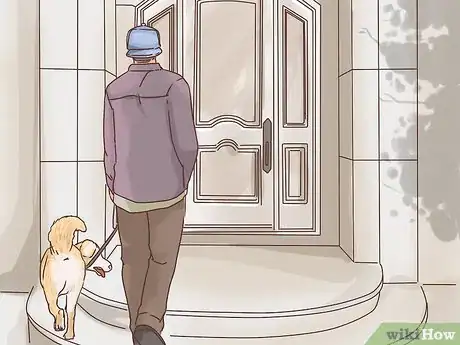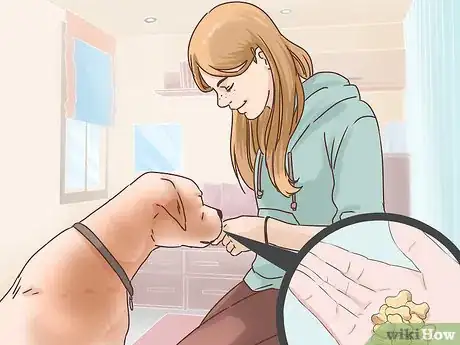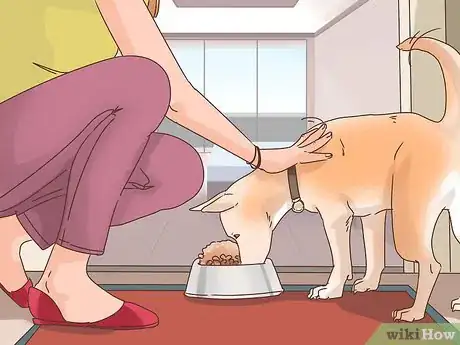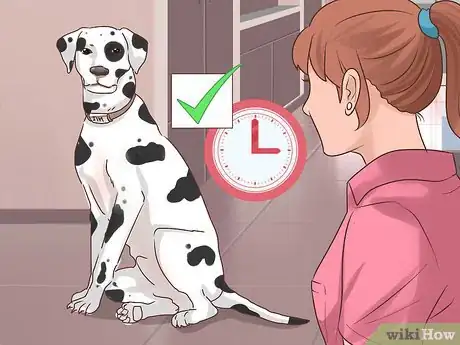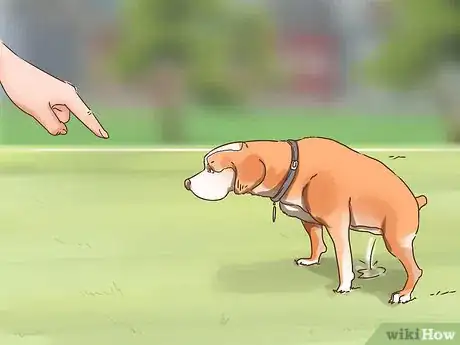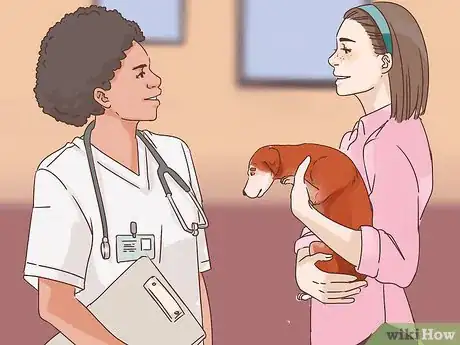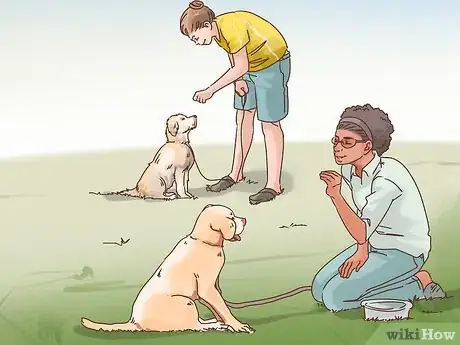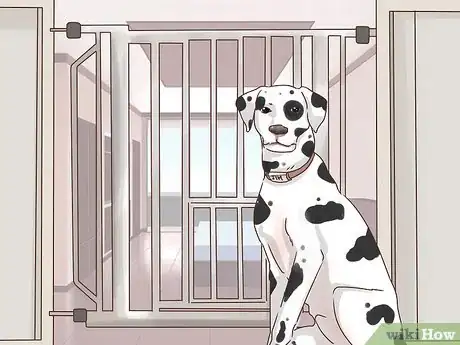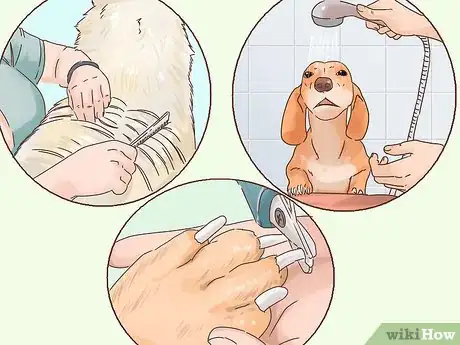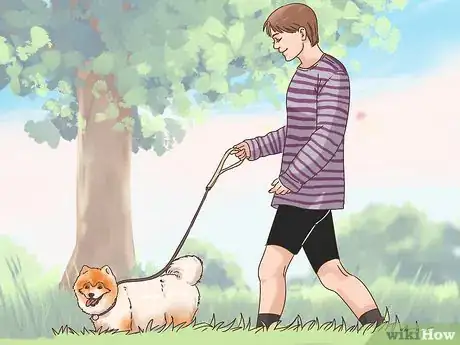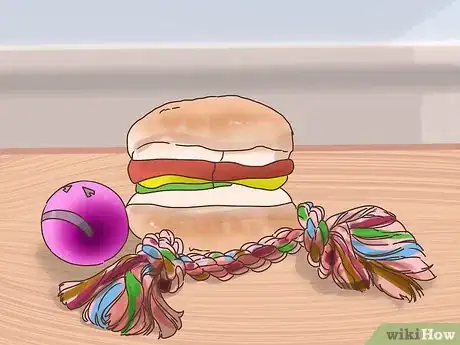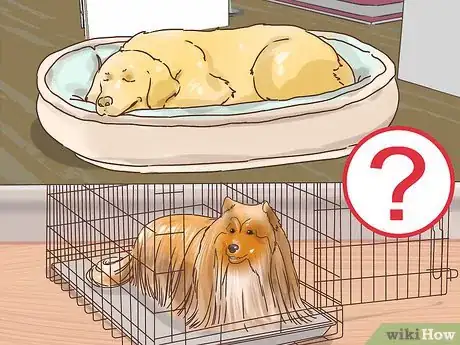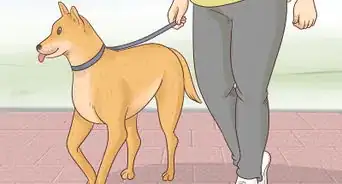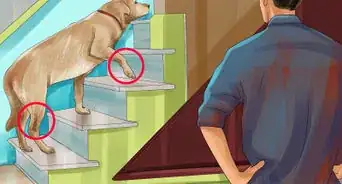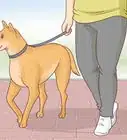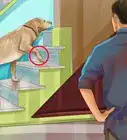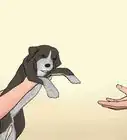This article was co-authored by Lauren Baker, DVM, PhD. Dr. Lauren Baker is a Veterinarian and Assistant Scientist at the University of Wisconsin-Madison. With over 10 years in veterinary medicine, she specializes in the concept of “one health,” which uses insights from veterinary medicine to help human medical research. She holds a Ph.D. in Comparative Biomedical Sciences, a Doctor of Veterinary Medicine, an MS in Comparative Biomedical Sciences, and a Bachelor’s degree in Psychology from the University of Wisconsin-Madison.
This article has been viewed 36,033 times.
As your dog gets older, you may want to bring it inside instead of leaving it out in the yard. With some patience and guidance, your dog can adjust to indoor life. To help your aging dog make the transition, get them used to the idea of being inside slowly, train them to learn indoor behavior, and provide plenty of exercise and mental stimulation.
Steps
Bringing Your Dog Inside
-
1Start slowly. If you want to make your outdoor dog into an indoor dog, you shouldn't just bring them inside and expect them to stay. You have to introduce them to being indoors slowly because they've lived their lives outdoors up until this point.
- Try bringing the dog inside using a leash or just leading them inside. Let them stay inside for a few minutes, then take them back outside. You can slowly let them stay in for longer periods of time.
-
2Give the dog treats to encourage them inside. If your dog is resistant or nervous about coming inside, use positive reinforcement. Connect being inside with treats and praise. Put treats in the doorway or lay down a line of treats to entice your dog inside.
- Once inside, give them another treat and lots of praise and love to help them learn that being inside the house is a good place.
Advertisement -
3Use food to bring the dog indoors. Another way you can help encourage your dog to come inside the house is to use their feeding time. You can use the feeding time to slowly bring them inside and help them get used to the new environment.
- Feed the dog on a mat outside. Once they get used to eating on the mat, place the mat just inside the door. If your dog won't go to the bowl, put a leash on them and bring them inside so they can eat. As the dog gets more comfortable, move the mat further and further inside the house.
Helping Your Dog Adjust
-
1Supervise the dog when they first move indoors. For the first few weeks your dog is inside, you should closely monitor them. You may want to keep them on a leash or not leave them unsupervised for long periods of time. This can help you train them to not mess in the house, chew on things, or engage in other negative behaviors.
- After about three weeks, you can stop watching your dog so closely if they are not doing any bad behavior.
-
2House train your dog. One of the things you'll have to do when you bring your outdoor dog indoors is house train them. They are used to going to the bathroom whenever and wherever they want, so they have to learn to only go outside.
- Take your dog outside to use the bathroom in the morning, before bed, after meals, and any other time you think they may need to go. It may help to take your dog out more often initially, every two to three hours, to help your dog adjust.
- Reward your dog's good behavior with treats and positive praise. Pick a treat that your dog greatly enjoys, and be sure to reward them as soon as they have relieved themselves. Don't wait until your inside, or your dog may not understand the reward.
-
3Take your dog to the vet. If your dog is showing any odd behavior, you should take them to the vet for a check up. Things like aggression, barking, excessive chewing, changes in eating or drinking habits, or inability to be house trained may point to a medical problem. It's a good idea to get your dog a checkup just in case.
- If you haven't taken your dog to the vet in awhile, you may want to get them a checkup when you decide to bring them indoors to ensure they remain healthy.
- Make sure that your dog is up to date on flea and tick prevention at this time, too, to avoid bringing unwanted bugs into the home.
-
4Take the dog to obedience classes. If you are afraid your dog won't behave well in the house, or if you can't seem to get them trained, then you may want to consider getting help. You can enroll your dog in obedience classes or hire a professional dog trainer.
- Professional training can help your dog become house trained, learn basic commands, and stop barking or chewing.
- Make sure you only hire trainers who use humane training techniques. Your dog should not be harmed or treated badly while learning. Make sure the training classes use positive reinforcement and praise.
-
5Keep your dog in a designated area until they adjust. Some dogs will immediately adjust to being inside. Others may take more time. If this is the case, consider keeping your dog in a dog-friendly room or a crate when you are not home. You may also use baby gates to keep the dog in certain rooms.
- This helps the dog stay out of trouble when you are not home. For example, your dog won't have an opportunity to mess in the floor or chew up furniture if you place them a specific room.
- Leave the dog toys and fresh water when you are gone. You may consider picking up food, though, if your dog is not used to free-feeding or has a tendency to overeat.
-
6Keep your dog groomed. When you bring your dog indoors, you want to make sure they stay clean and groomed. Give your dog regular baths. Comb and trim their hair if they are a long haired breed. Keep their nails clipped. If you don't want to do all of this yourself, you can take them to the dog groomers.
- If your dog has fleas or ticks, you can talk to the vet about medication to help get rid of them.
Looking After Your Dog's Well-Being
-
1Exercise your dog. Dogs who are used to being outside may be more used to running around the yard and expending their energy. When you bring them indoors, they may not get the same level of exercise. This can cause them to bark more or chew on things. Make sure you are helping your dog get enough exercise.
- This may mean you need to take your dog walking every day. You can also take them into the yard and let them run around or play fetch with them.
-
2Get your dog toys. When you bring your dog indoors, you should get some toys for your dog, or bring in any favorite toys your dog had outside. Without toys, your dog may get bored. Dogs need mental stimulation, and toys helps keep them entertained.
- Dogs also love to chew, and toys gives your dog something to chew so they don't chew on furniture, shoes, or household objects.
-
3Give your dog a sleeping spot. When you move your dog indoors, you should decide where it's going to sleep. Many experts suggest letting your dog sleep in a crate because it gives them their own space. Some people give dogs a bed in their room. Determine where you want your dog to sleep and show them that each night.[1]
- Don't let your dog sleep on furniture if you are not going to want them to always sleep on furniture. Make the rules about where the dog sleeps clear when you bring them indoors, and be consistent to help promote good behavior.
About This Article
To make an outdoor dog an indoor dog as it ages, gradually transition it to living inside instead of doing it suddenly so your dog has time to adjust. For example, you can start by bringing it indoors for a few minutes at a time, and then gradually increase how long you keep it inside for. If your dog seems hesitant to come inside, try using treats or food to motivate it to spend time indoors. Additionally, keep your dog confined to a designated area while they adjust, and closely monitor them indoors so they don't chew on things or make a mess. You'll likely also need to house train your dog as soon as possible since it's used to going to the bathroom wherever it wants. For tips from our Veterinary co-author, like how to keep your old dog healthy and happy after moving it indoors, keep reading!
